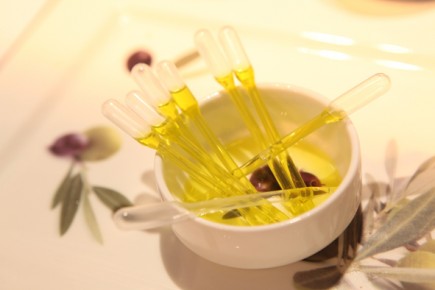
Olive oil, an impure fat in liquid form and insoluble in water, is predominantly meant to be consumed as a - fundamental - food in human nutrition. As a type of food it constitutes a great source of energy and contains nutrients that play an important part in maintaining our good health. One gram of olive oil produces 9.3 Kcal (kilocalories), while the balanced amount of glycerides in olive oil is the same as the amount of fatty acids in breast milk. In addition, olive oil is rich in antioxidants (mainly tocopherols and polyphenols).
The chemical composition of olive oil comprises a large group of substances of great importance for the human body, such as different fatty acids, carbohydrates, vitamins, pigments, minerals (micronutrients) etc.
The fatty acids constitute the greatest part of the olive oil’s chemical compounds and are distinguished between saturated fatty acids (such as the Palmitic Acid and the Stearic Acid which are both solid) and unsaturated fatty acids (such as the Oleic Acid, Linoleic Acid and Linolenic Acid which are all liquid). The unsaturated fatty acids make up more than 60 % of the olive oil and this is the reason why olive oil is in liquid form. It is not yet scientifically proved that the saturated fatty acids raise the levels of cholesterol. On the other hand, it is confirmed that the unsaturated fatty acids have no effect on cholesterol.
Carbohydrates (such as squalene, terpene alcohols and sterols) make up 3 - 3.5 % of olive oil. According to a number of research studies, squalene has preventive qualities against the growth of breast cancer, while the positive to the bile tube qualities of the terpene alcohols seem to contribute to the lowering of cholesterol.
Pigments, such as carotene and chlorophyll, and sterols in conjunction with phenols exposed to sunlight prevent the oil from getting sour. Sterols, especially β-Sitosterol (beta-Sitosterol), prevent the absorption of cholesterol. Carotenes and chlorophylls are a great aid for human metabolism, cellular growth and the healing of wounds.
Phenols, polyphenols and phenolic acids have great antioxidant properties and protect the olive oil from any damage that is can possibly be caused by high temperatures while cooking, and generally by peroxidase and the creation of free roots.
Triglycerides, an ester derived from the mixture of three saturated fatty acids with glycerol, are pretty sensitive. Under the influence of the steapsin enzymes, the ester and unsaturated linkages of the glyceride break down and the glyceride is converted into glycerol and free fatty acids. The result of the breakdown of the triglycerides is the increase of the acidity in olive oil, while oil might become more sour.
Chemical degradation in olive oil and its fatty acids caused by the two abovementioned issues is one of the most serious problems that affect the olive oil’s quality.
Additionally, the existence of Vitamin E in olive oil is extremely important, as, among its other positive qualities, it also plays an important part in the prevention of osteoporosis both in males and females.
(photo via: oliveoiltimes)







